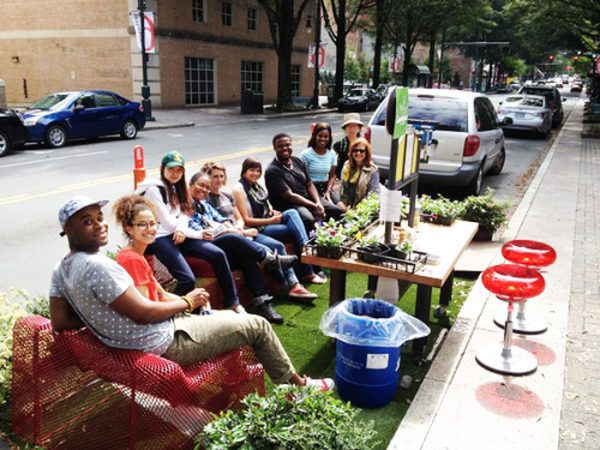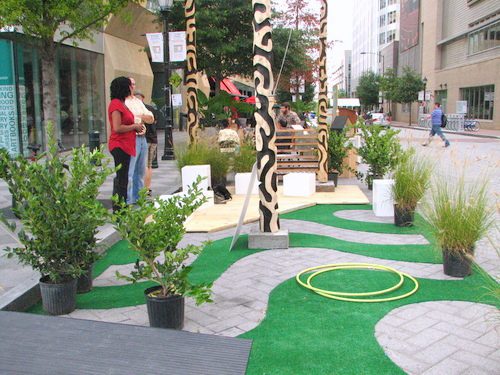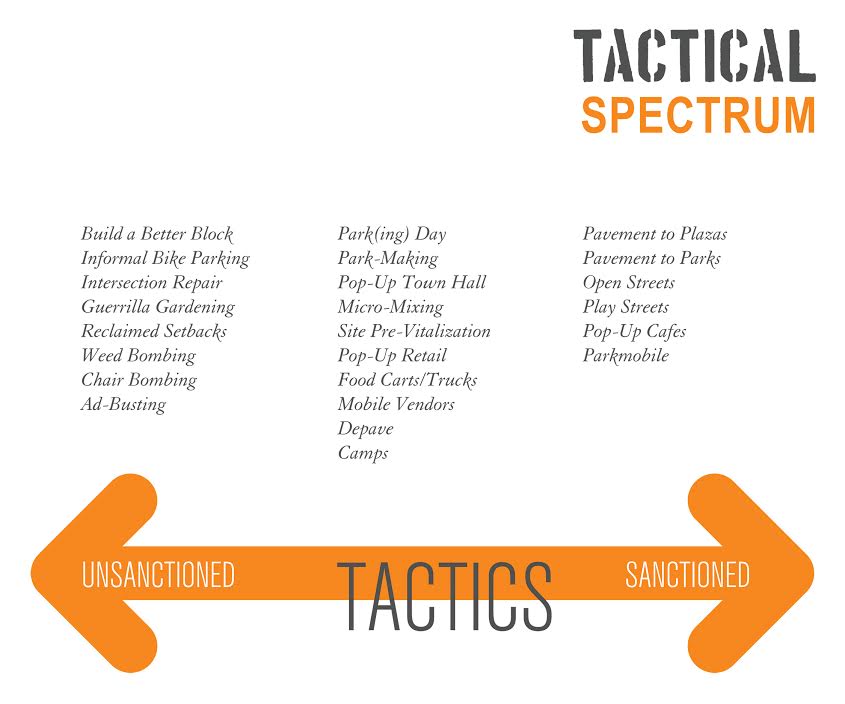Will tactical urbanism find a home in Charlotte?

Mike Lydon and Anthony Garcia’s much anticipated Tactical Urbanism – Short Term Actions for Long-Term Change is due out in a few weeks. Reading the galleys brings to mind how widespread and quickly this global movement has grown, Charlotte and Raleigh being no exception.
The term tactical urbanism refers to quick, often temporary projects aimed at making a city, or city neighborhood more walkable, more engaging, or just more fun. It’s spontaneous, experimental and pragmatic: Let’s try something and see how it works. If it doesn’t, try it a different way or go back to square one.
I got to know primary author Lydon, a Millennial-generation urban planner, shortly before he relocated from Miami to Brooklyn, New York. He now globe-trots as a movement spokesperson and consultant to locales as far afield as Christchurch, New Zealand.
This book is an entertaining, no-nonsense and slightly irreverent read with lots of good examples. They signal a growing and significant shift in how we can take part in altering and improving place-making in cities. As Lydon explains, a key motivation behind tactical urbanism is to short-circuit the red-tape and frustrating delays of the conventional planning and building process. It gets the basic elements of projects on the ground quickly and cheaply, even if at times doing so goes “outside the system.”
Lydon emphasizes tactical urbanism’s special appeal with the Millennial generation, partly because of the huge role social media has played in its success and partly because so many city-living Millennials are restless for change. Projects can be easily identified with catchy monikers like Intersection Repair, DIY Crosswalks, DIY Bike Lanes, Open Streets, Build a Better Block, Walk [Your City], Pop-Up Retail and Pop-Up Plazas. Numerous examples span the country from a parking lot conversion in Somerville, Mass., to the revival of portions of the Broad Avenue corridor in a run-down neighborhood of Memphis.
Tactical urbanism pilot projects can legitimately occur anywhere along what the book calls a “tactical spectrum,” from illegality to full government sanction.
After failed attempts to get government help, Anthony Cardenas of Vallejo, Calif., took matters into his own hands early one morning in May 2013 when he painted a badly needed crosswalk onto a dangerous, unmarked intersection near his home. He was summarily whisked to the county jail on vandalism charges. Soon released on a $15,000 bond (paid by an anonymous donor), his neighbors gave him a hero’s welcome. His harmless act of defiance and others like it fall at one end of the spectrum – an unsanctioned, “guerilla” maneuver.
At the other end are publicly sanctioned campaigns involving wide participation from a combination of public sector and grass-roots sources. Their costs and logistics are more complex, and they can take several iterations to iron out the kinks. Perhaps the most remarkable example in this book has been the conversion of Times Square, one of several publicly led initiatives that have radically transformed the streetscape of the Big Apple. It all began in 2009 as a pilot project with the rerouting of traffic by the New York City transportation department, widened sidewalks, introduction of bike lanes and the creation of a pedestrian-only zone. In that zone, hundreds of $15 plastic folding chairs were plopped down to give folks the incentive to hang around.
After five years of tweaking, reinvestment and evaluations, Times Square today is a place where pedestrians and cyclists have equal parity with motorized vehicles, retail sales volume has increased dramatically, and traffic congestion has been kept within reasonable limits. Its identity as a one of the world’s major destinations has been fundamentally enhanced.
“The bottom line is to bring projects to life that may have been dormant, dysfunctional or ignored for years,” Lydon said in an email interview. “And once that is achieved, to figure out how to make them work on a permanent basis. Tactical urbanism is not an umbrella term per se, but a specific approach that uses a variety of means to change public policy, physical infrastructure, the prevailing culture … or all three.”
 Charlotte has seen some modest versions of tactical urbanism, most notably its September 2014 participation in the worldwide PARK(ing) Day event, an international initiative to highlight how parking places might become parks. Young urban designers Keihly Moore and Alex Borisenko got city approval to convert six curb-side parking spots uptown into do-it-yourself parklets for a day.
Charlotte has seen some modest versions of tactical urbanism, most notably its September 2014 participation in the worldwide PARK(ing) Day event, an international initiative to highlight how parking places might become parks. Young urban designers Keihly Moore and Alex Borisenko got city approval to convert six curb-side parking spots uptown into do-it-yourself parklets for a day.
Moore and Borisenko organized and facilitated all of the logistics with support from over a dozen partners, including the John S. and James L. Knight Foundation, Charlotte Center City Partners, the U.S. Green Building Council and the UNC Charlotte College of Arts + Architecture. Volunteers built nine Little Free Libraries to be donated to surrounding neighborhoods after the event. And now, Charlotte Department of Transportation officials say they’re working with other city agencies to set guidelines, in response to requests for more parklets.
Other indications that tactical urbanism may be gaining some traction in Charlotte are the efforts to grant zoning legitimacy to food truck vendors in various Charlotte neighborhoods and “guerrilla” vegetable gardens popping up here and there. To what extent these develop into long-term commitments remains to be seen, but a good place to start would be to follow Lydon’s advice: Make sure pilot projects are evaluated thoroughly and objectively once the props are removed. Learn from mistakes as well as successes.
Will a crew of guerrilla artists paint bike logos and stripe bike lanes on streets where the need for them hasn’t yet been met? Will a cadre of volunteers emerge to convert cul-de-sac dead ends into neighborhood gathering places? Will “pop-up” retail take the place of empty store fronts in strip shopping centers? Retail pop-ups are already on the mind of Chris Hemans, the new director of retail for Charlotte Center City Partners.
Who knows? Tactical urbanism may be hanging around Charlotte for the long haul.
Martin Zimmerman is a planner and consultant who directs Green Mobility Planning Studio USA. He was previously director of facilities planning for UNC Charlotte and was executive director for the nonprofit Charlotte Area Bicycle Alliance. He does not own a car.
Opinions in commentary articles are those of the author and not necessarily those of the UNC Charlotte Urban Institute or the University of North Carolina at Charlotte.
Tactical Spectrum Diagram (below), courtesy of The Street Plans Collaborative
